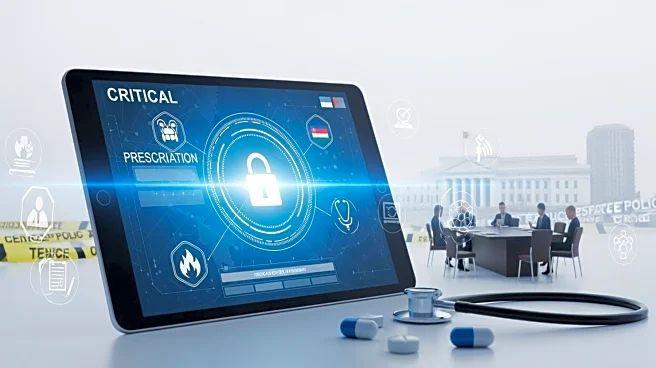What's Happening?
E-prescribing technology is revolutionizing the way prescriptions are managed in the U.S., particularly in the context of opioid safety and compliance with Prescription Drug Monitoring Programs (PDMPs). This digital approach replaces traditional handwritten
prescriptions with secure, interoperable systems that connect healthcare providers and pharmacies. By integrating PDMP data directly into prescribing workflows, e-prescribing platforms provide clinicians with immediate access to patient medication histories, allowing them to verify allergies, identify overlapping treatments, and detect potential adverse drug interactions before finalizing prescriptions. This system not only reduces paperwork errors and enhances prescription processing efficiency but also significantly lowers the risk of prescription fraud. The technology includes security features for identity verification, ensuring that prescribers' identities are confirmed before prescriptions are written, thus preventing unauthorized access and fraud.
Why It's Important?
The integration of e-prescribing technology is crucial in addressing the ongoing opioid crisis in the U.S. Despite a decline in prescription rates, opioid-related overdoses have risen, highlighting the need for more effective management of opioid prescriptions. E-prescribing platforms streamline the process by embedding PDMP checks, which help clinicians reconsider opioid choices and implement stricter patient monitoring. This enhanced transparency promotes responsible prescribing practices and actively combats potential drug diversion. Additionally, e-prescribing encourages clinicians to consider the duration and dosage of opioid prescriptions, leading to more cautious opioid use. The technology also supports the prediction of opioid misuse risk through AI-driven insights, allowing for early intervention and prevention of addiction. By reducing high-risk opioid prescriptions and improving prescribing behaviors, e-prescribing technology plays a vital role in creating a safer healthcare ecosystem.
What's Next?
The adoption of e-prescribing technology is expected to expand further, particularly in underserved rural areas where its implementation has lagged. Bridging the digital and logistical gap in these regions is essential to ensure patients receive safer, data-driven pain management solutions. Extending e-prescribing infrastructure and expanding pharmacy access can reduce the need for larger prescriptions by providing patients with more frequent and convenient access to medications. As the technology continues to evolve, ongoing refinements and a focus on communities in need will move healthcare closer to a future where responsible prescribing is the universal standard. Stakeholders, including healthcare organizations and policymakers, are likely to support initiatives that promote the widespread adoption of e-prescribing to enhance patient safety and combat opioid misuse effectively.
Beyond the Headlines
The shift to e-prescribing technology not only addresses immediate concerns related to opioid safety but also has broader implications for the healthcare industry. By reducing prescription fraud and enhancing transparency, e-prescribing contributes to a more reliable and fraud-immune prescribing system. The integration of AI-driven insights into prescribing practices represents a significant advancement in personalized medicine, allowing for tailored interventions based on individual patient data. Furthermore, the technology's ability to streamline workflows and improve efficiency can free up healthcare providers' time, enabling them to focus more on patient care. As e-prescribing becomes more prevalent, it may also influence regulatory policies and healthcare standards, driving innovation and improving overall healthcare delivery.














